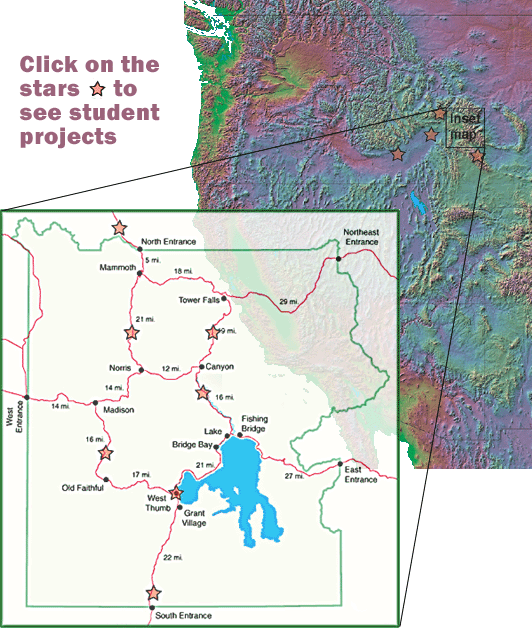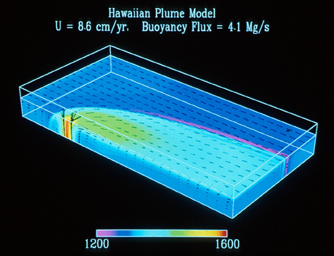Study Tour
Study Tour - Yellowstone Park
As a culmination of the Geodynamics seminar on Plume-Ridge Interactions the class, accompanied by several faculty, took a field trip to the Yellowstone Plateau. The thesis of the trip was to observe the manifestations of a mantle plume in the actively deforming western United States.
During the field trip each of the students was responsible for leading discussion on various aspects
of the volcanology, tectonics, hydrothermal activity, and biology associated with the hot spot and its
thermal signature.
The map below contains hotlinks to overviews of each of the student led discussions.
Projects by Student
Behn, Mark
Boettcher, Margaret
1983 Borah Peak Earthquake, M 7.3
Braun, Mike
Yellowstone
deMartin, Brian
Seismic structure of the Yellowstone Hotspot
Drout, Amy
Obsidian Cliffs and Basalt/Rhyolite Mixin
Hesse, Marc
West Thumb Geyser Basin
Kvasness, Astri
The Menan Buttes, Madison County-Jefferson County border, southeastern Idaho
Licciardi, Joe
Chronology of the Northern Yellowstone Ice Cap
Standish, Jeff
Lava Creek Tuff
Thompson, Janelle R.
The Microbial Ecology of Yellowstone Hot Springs
Workman, Rhea
Craters of the Moon Lava Field: a History of Volcanism

Course Outline
1. Background on Tectonics and Mantle Convection
- How do plumes and ridges fit into ideas regarding mantle convection
- What is a plume, how are they distributed around the globe?
- How do the properties of plumes and ridges vary?
- What would be a canonical model for the chronology of a p/r interaction?
- What are the burning, unanswered questions regarding plumes, ridges,
and p/r interactions?
- What kinds of data and modeling are needed to answere the important
questions?
2. Case Study 1: Iceland/Northern MAR - Stuck in the middle?
- What is the pattern of mantle flow beneath Iceland?
- How big is the Iceland plume? Where is it?
- How far downrift can the chemical and mechanical influence of
the Iceland plume be traced?
- How and where is the plume fragmented and distributed to discrete
volcanic systems?
- What is the role of the Iceland plume in the early stages of rifting
on the northern MAR?
- What do the V-shaped ridges tell us about the p/r interaction
and its influence on parameters such as lithospheric strength and
upper mantle flow?
3. Case Study 2: Galapagos/GSC - Gone but not forgotten.
- How has the interaction between the Galapagos plume and the Galapagos
Spreading Center evolved over time?
- How does lava chemistry vary along the GSC and what does this
imply regarding the p/r interaction?
- What is the present pattern of mantle flow beneath this system?
-What does the mantle matrix do between the two upwelling features?
- Is there still a melt connection?
- How big is the Galapagos plume? Where is it?
4. Case Study 3: Cobb/JdFR - The first days are the hardest
days.
- Is the Cobb hotspot a plume?
- How has it behaved in the hot-spot reference frame?
- Does it have a geochemical signature?
- Where is it presently located?
- How deep is it rooted?
- What is the pattern of mantle flow beneath this system?
- When did the JdFR start bending towards the Cobb hotspot?
- How is melt distributed beneath the central JdFR?
- How does lava chemistry vary along the JdFR/Cobb region?
- What patterns of matrix and melt flow are consistent with the
observational and theoretical constraints?
- How might long-term observatories, such as NeMO and Neptune contribute
to our understanding of the p/r interaction?
5. Esoterica
- How do ridges, plumes, and p/r interactions influence the global
biogeography of chemosynthetic systems?
- How do the myriad millions of near-ridge seamounts relate to p/r
interactions?
- How fixed is the hot spot reference frame?
- Can large plumes create new plate boundaries?
- How deep is the source region for hotspots?

Numerical model of the Hawaiian Plume (from Ribe and Christensen, JGR Vol. 99, pp. 669-682, 1994.)